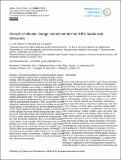| dc.contributor.author | Velders, G. J. M. | |
| dc.contributor.author | Solomon, Susan | |
| dc.contributor.author | Daniel, J. S. | |
| dc.date.accessioned | 2014-06-23T16:39:21Z | |
| dc.date.available | 2014-06-23T16:39:21Z | |
| dc.date.issued | 2014-05 | |
| dc.date.submitted | 2014-03 | |
| dc.identifier.issn | 1680-7324 | |
| dc.identifier.uri | http://hdl.handle.net/1721.1/88065 | |
| dc.description.abstract | Chlorofluorocarbons (CFCs) are the primary cause of ozone depletion, and they also contribute to global climate change. With the global phaseout of CFCs and the coming phaseout of hydrochlorofluorocarbons (HCFCs), the substitute hydrofluorocarbons (HFCs) are increasingly used. While CFCs were originally used mainly in applications such as spray cans and were released within a year after production, concern about the ozone layer led to reductions in rapid-release applications, and the relative importance of slower-release applications grew. HFCs are now mainly used in refrigerators and air conditioners (AC) and are released over years to a decade after production. Their containment in such equipment represents banks, which are building up as production grows. A key finding of our work is that the increases of HFC banks represent a substantial unseen commitment to further radiative forcing of climate change also after production of the chemicals ceases. We show that earlier phaseouts of HFCs would provide greater benefits for climate protection than previously recognized, due to the avoided buildup of the banks. If, for example, HFC production were to be phased out in 2020 instead of 2050, not only could about 91–146 GtCO2-eq of cumulative emission be avoided from 2020 to 2050, but an additional bank of about 39–64 GtCO2-eq could also be avoided in 2050. Choices of later phaseout dates lead to larger commitments to climate change unless growing banks of HFCs from millions of dispersed locations are collected and destroyed. | en_US |
| dc.language.iso | en_US | |
| dc.publisher | Copernicus GmbH on behalf of the European Geosciences Union | en_US |
| dc.relation.isversionof | http://dx.doi.org/10.5194/acp-14-4563-2014 | en_US |
| dc.rights | Creative Commons Attribution | en_US |
| dc.rights.uri | http://creativecommons.org/licenses/by/3.0/ | en_US |
| dc.source | Copernicus Publications | en_US |
| dc.title | Growth of climate change commitments from HFC banks and emissions | en_US |
| dc.type | Article | en_US |
| dc.identifier.citation | Velders, G. J. M., S. Solomon, and J. S. Daniel. “Growth of Climate Change Commitments from HFC Banks and Emissions.” Atmospheric Chemistry and Physics 14, no. 9 (May 12, 2014): 4563–4572. | en_US |
| dc.contributor.department | Massachusetts Institute of Technology. Department of Earth, Atmospheric, and Planetary Sciences | en_US |
| dc.contributor.mitauthor | Solomon, Susan | en_US |
| dc.relation.journal | Atmospheric Chemistry and Physics | en_US |
| dc.eprint.version | Final published version | en_US |
| dc.type.uri | http://purl.org/eprint/type/JournalArticle | en_US |
| eprint.status | http://purl.org/eprint/status/PeerReviewed | en_US |
| dspace.orderedauthors | Velders, G. J. M.; Solomon, S.; Daniel, J. S. | en_US |
| dc.identifier.orcid | https://orcid.org/0000-0002-2020-7581 | |
| mit.license | PUBLISHER_CC | en_US |
| mit.metadata.status | Complete | |
